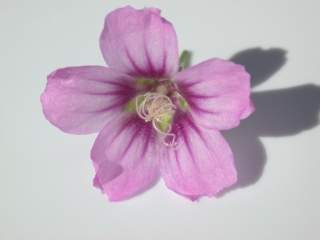 Lavatera mauritanica Durieu
Lavatera mauritanica DurieuLavatera mauritanica ssp davaei (Coutinho) Coutinho
back to Tree Mallows
back to Digital Herbarium
more images
The Lavatera Pages
 Lavatera mauritanica Durieu
Lavatera mauritanica Durieu
Lavatera mauritanica ssp davaei (Coutinho) Coutinho
![]() Malva mauritánica
Malva mauritánica
Distribution: Morocco [6], the western part of the Algerian coast (from Algiers to Monastaganem, and from Arzew to Oran [4]) (ssp. mauritanica), south and central Portugal (ssp. davaei), Gibraltar, and southern [2] and eastern Spain, including las islas Columbretes off the coast of Castellon province in Valencia, and possibly in the Balearic Islands. It is also found on the Spanish island of Alboran off the Mediterranean coast of Morocco. Flora Europaea [2] assigns all the European populations to ssp. davaei.
It is recorded as an introduced species in New South Wales.
Habitat: maritime rocks.
Identification: Vegetatively Lavatera mauritanica is similar to most other species of Malva section Malva and Lavatera section Anthema, especially when young.
It is most readily identified when in flower, when it can be identified by the dark base to the petals and oblong or narrowly ovate, nearly free, epicalyx segments; the latter distinguishes it from Lavatera arborea, which has broader much fused epicalyx segments, and the former from the remaining related species of Malva and Lavatera.
Flora Europaea [2] distinguishes it from Lavatera cretica by the strongly accrescent calyx in fruit and by the presence of ridged mericarps with flat dorsal faces and sharp, denticulate, angles. The former characteristic is not reliable for all populations of Lavatera cretica. I suggest that in flower and fruit Lavatera mauritanica can be distinguished most readily from Lavatera cretica by the oblong or narrowly ovate, nearly free, epicalyx segments. It may also be distinguished by the strongly ridged mericarps with sharp angles between the dorsal and lateral faces.
Technical Description
Erect ephemeral, annual or biennial herb, to 60-105-120 cm, sometimes as little as 8 cm, initially single-stemmed, later branched, developing side shoots at the same time as flowers, stellate-tomentose on all parts other than the corolla. Stems green, suffused red in age, sparsely stellate-tomentose; foliage alternate, stipulate and long-petiolate; stipules 5-7 mm, narrowly triangular or triangular-ovate, recurved or not, pubescent, ciliate; petioles up to 13 cm long, green, and stellate-tomentose; laminae simple, cordate, suborbicular, 7(-9)-palmately nerved, shortly 5-7-lobed, upper leaves truncate or broadly cuneate and more distinctly lobed; dentate, tomentose on upper and lower surfaces, often with a small red spot at the junction of blade and petiole, to 12 cm wide × 10 cm long, much smaller on side shoots; inflorescence indeterminate, an initially corymbose leafy raceme; flowers hermaphrodite, protandrous, involucellate, borne upright, singly, in pairs, or in fasciculate clusters in the axils of upper leaves and of leaves of side shoots (typically clusters of 4 in the primary inflorescence and singly in co-florescences); pedicels (much) shorter than the subtending petiole, longer on earlier flowers in a cluster, to 3 cm; bracteoles 3, nearly free, narrowly oblong to ovate, apex obtuse, tomentose, ciliate, 5 mm long at anthesis, accrescent to 10 mm in fruit; calyx valvate in aestivation, sepals 5, accrescent and connivent in fruit, connate for about half their length, free portions broadly triangular-ovate, acuminate, lobes ciliate; corolla convolute in aestivation, petals 5, spirally arranged, hypogynous, adnate at the base to the staminal column, retuse, 8-15 mm long, rose-pink, with a darker purplish eye and 3 similarly coloured parallel veins; staminal column white, tomentose, about 7 mm long, antheriferous in the upper quarter; anthers white, reniform, unilocular; ovary 8-9-loculate, locules uniovulate, ovules ascending, placentation axile; style branches white, filiform, twisted, as many as the locules, stigmas introrsely decurrent; fruit schizocarpous, verticillate; mericarps (6-)8-9, dorsal faces flat, rugosely reticular, sparsely hairy, lateral faces flat, smooth, with curved striate ridges, angles sharp and denticulate, separating when mature from each other and the fruit axis; seed reniform, campylotropous, conformed to the cell, which it completely fills; the testa crustaceous, smooth; embryo incurved into an incomplete ring around the scanty soft or mucilaginous albumen, cotyledons broad and foliaceous, somewhat infolded, radicle centripetal-inferior.
Description
| An erect annual, less often an emphemeral or biennial, growing to 2-4ft in height. The vegetative parts have a covering of stellate hairs, though this is less prominent than on some related species of Malva and Lavatera. The main stems are upright, green, and sparsely covered in short, impersistent, hairs. With age they develop a reddish tinge. Side stems are born sub-horizontally and in a well grown plant can reach an appreciable fraction of the length of the main stem. |
||
| The leaves are borne alternately (one per node), subtended by two stipules. They are simple, sub-orbicular, palmately veined, shallowly and bluntly 5-7 lobed, and toothed, with a cordate base, and are borne on long petioles up to 5" in length. They reach up to 4" in width and 3" in length. Immature and later leaves are smaller, and more deeply and acutely lobed. The petioles have a covering of hairs similar to that of the stems, but more prominent.Both sides of the leaves also bear hairs. The leaves usually, but not universally, also display a small purplish-red spot at the junction with the petiole. |
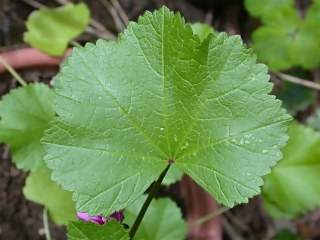 |
|
|
|
||
| The stipules are recurved, narrowly triangular, and up to 5mm in length. They are marked by a linear pattern of darker and lighter green colouration. They are pubescent, and also have a fringe of longer ciliate hairs. |
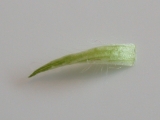 |
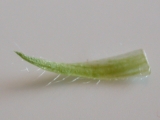 |
| The flowers are smallish, around 1" in diameter, and are borne in clusters (pairs) in the leaf axils, from early summer onwards. The flower pedicels are shorter than the mature leaf petioles, which means that the flowers can be, but are not always, partially obscured by the leaves. The flower consists of an epicalyx of 3 bracteoles, a calyx of 5 sepals, a corolla of 5 petals, an androecium and a gynoecium. |
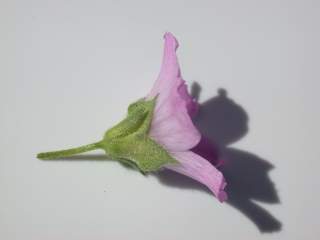 |
|
| The pedicel is green and pubescent. The bracteoles are free nearly to the base, and are narrowly oblong to ovate in shape, with an obtuse apex. They are pubescent, and also have a fringe of longer ciliate hairs. They are shorter than the sepals, being around 5mm long in flower, extending to around 10mm long in fruit. They are asymmetrically disposed (at three quarters of the compass). |
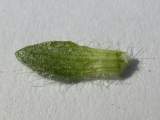 |
|
| The sepals are densely pubescent, triangular-ovate, acute, about half the length of the petals, and are joined (connate) for about half their length. In fruit they grow to cover the ripe schizocarp. |
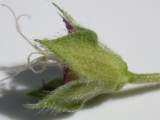 |
|
| The petals are a rose-pink, with a darker purplish eye and veining, and a paler claw. They have a scattering of fine hairs towards the centre of the flower. They are around 12mm (8-15mm) in length. The apices are slightly notched. The bases are cuneate, allowing a view of the underlying sepals. |
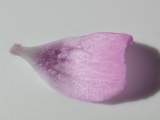 |
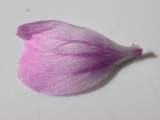 |
| The fruit is a schizocarp, consisting of about (6)-8-9 nutlets (mericarps), obscured from direct view by the calyx. It is about 1cm in diameter. |
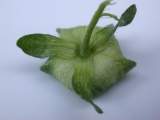 |
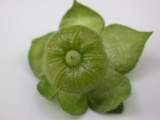 |
|
|
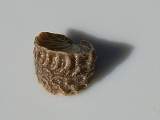 |
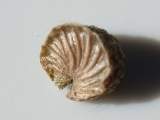 |
| L. mauritanica has a short tap root. | ||
Cultivation
Lavatera mauritanica can be treated as an annual or as a biennial. For treatment as an annual seed may be sown indoors, lightly covered, in early to mid-spring, for planting out later. Germination is easy and rapid. Alternatively sow outdoors in the flowering position in mid- to late spring. From germination to flowering takes 6-8 weeks. After a first flush flowering continues until winter. I have not observed mature plants to survive the winter, but have not tried overwintering them protected from frost.
Seed sown sufficiently late in the year will not flower in that year, and will overwinter and flower in the following year. It has been observed to survive a mild winter, but given the species' native habitat (coastal locations in a Mediterranean climate) one can suspect that it will not cope with severe winters. There remains the alternative of treating it as a half-hardy biennial, i.e. overwintering it under glass or indoors.
Seed set is good, even in the absence of pollinating insects. (Therefore I suspect that it is capable of self-fertilisation.) Hence seed may be collected for future use.
Cytology
Lavatera mauritanica is a dodecaploid with 84 chromosomes.
Variation
ssp. davaei differs from the type in having a less divided epicalyx, more accrescent sepals, and less rough mericarps.
The purplish-red spot on the leaf at the junction with the petiole is not present in all specimems. Circumstantial evidence suggests that this variation may be environmental in evidence.
Taxonomy:
Lavatera mauritanica Durieu in Duchartre, Rev. Bot. 2: 436 (1847)
Lavatera mauritanica ssp. davaei Coutinho, Fl. Port. 402 (1913)
Ray [3] states that morphologically L. mauritanica agrees with the species of Lavatera that he transferred to Malva, but refrained from reclassifying L. mauritanica in the absence of confirming DNA evidence.
Escobar et al [7] have found that its ITS locus (nrDNA) is closest to Lavatera arborea, and its cpDNA (psbA-trnH and trnL-trnF) is nested in Malva parviflora. This suggests that Lavatera mauritanica is an allopolyploid hybrid between Lavatera arborea and Malva parviflora (or one of the related weedy mallows, not all of which were sampled by Escobar et al), or between forms ancestral to those species. We can conclude that, in common with Lavatera arborea and some other species, Lavatera mauritanica should be transferred to Malva, where, as far as I can tell, the correct name would be Malva durieui Spach.
Synonymy:
of subspecies davaei
Hybrids: hybrids with Malva sylvestris 'Zebrina' [5, 8] and Malva sylvestris 'Braveheart' [8] have been observed.
The hybrid with 'Zebrina' is self-sterile, but backcrosses with Malva sylvestris 'Zebrina' and Lavatera mauritanica [5]. These observations suggest that L. mauritanica has the same chromosome number as Malva sylvestris 'Zebrina', which can be explained either by the latter being a tetraploid form of the common mallow, or by the existence of a hexaploid (2n=42) form of L. mauritanica.
The hybrid with 'Braveheart' is highly sterile, both with its own pollen, and with that of Malva sylvestris. About half a dozen seeds were obtained from a plant (which bore 50-100 flowers); however none of these seeds germinated.
Many crosses within Malva section Malva (including Lavatera section Anthema) can be made successfully, which suggests that hybridisation with dodecaploid forms of M. verticillata may be possible.
References
Bibliography
back to Tree Mallows
back to Digital Herbarium
more images
The Lavatera Pages
Acknowledgements and Copyright
photographs © 2002 Stewart Robert Hinsley
text and HTML © 2002, 2003, 2004 Stewart Robert Hinsley